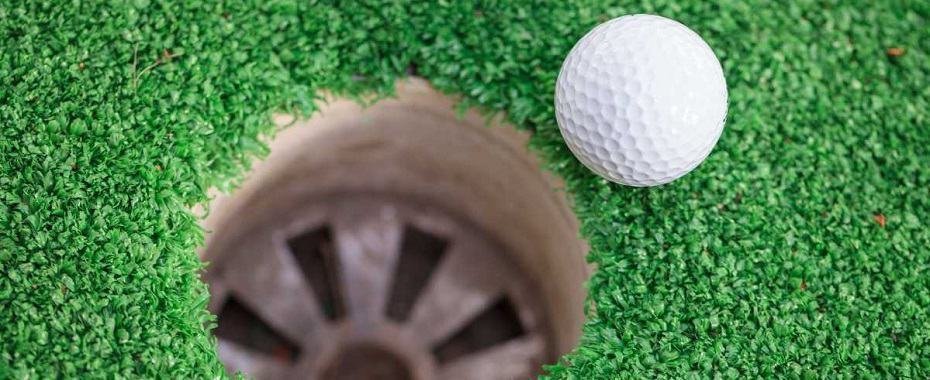As an Amazon Associate, I earn from qualifying purchases. There is no extra cost to you. Thank you if you use our links; we appreciate it! Learn More.

Golf, a sport long associated with lush green landscapes and pristine environments, has increasingly been under scrutiny for its environmental impact. One often overlooked aspect is the environmental toll of traditional golf balls. As golfers strive to make more sustainable choices, the industry is responding with innovative solutions such as introducing eco-friendly and biodegradable golf balls.
This article looks at the evolution of golf balls and the environmental concerns regarding golf ball manufacturing. It also touches on how making sustainable choices can make a significant difference.
The Evolution of Golf Balls: A Look Back
Before addressing the environmental concerns, a little history on the golf ball is in order, just to appreciate how far they have come.
The highly sophisticated and technologically advanced balls we see today are a far cry from those in the past. The earliest golf balls, dating back to the 14th century, were crafted from wood, often beech or boxroot, carved into a round shape.
As golfing progressed, so did the nature of the balls.
In the 17th century, the featherie ball emerged, featuring a leather cover stuffed with feathers. This design provided improved aerodynamics but was labor-intensive to produce.
Fast forward to the 19th century which brought transformation with the introduction of the Gutta Percha ball, made from the sap of the Gutta tree. This material offered a more consistent and durable alternative, revolutionizing the game.
The advent of the rubber-wound ball in the early 20th century marked another milestone. The subsequent transition to synthetic materials like Surlyn and urethane in the mid-20th century brought about unprecedented advancements in ball design, combining durability with precise performance characteristics.
In recent years, the focus has shifted toward sustainability, giving rise to eco-friendly golf balls that incorporate renewable materials This exemplifies a contemporary commitment to both performance and environmental responsibility.
But why was this shift necessary?
Read on and find out.
The Environmental Toll of Traditional Golf Balls: A Hidden Menace
Traditional golf balls made of synthetic materials like Surlyn or urethane pose a considerable threat to the environment.
The production of these balls involves the extraction of non-renewable resources and the use of energy-intensive processes. This contributes to carbon emissions and environmental degradation.
Moreover, when golf balls are lost or discarded during play, they become a long-lasting pollutant in the natural ecosystem.
These conventional balls can take centuries to decompose due to their durable composition, releasing harmful toxins into the soil and water as they break down. The impact on aquatic ecosystems is particularly concerning, as the plastics and chemicals in the balls can harm marine life and disrupt delicate ecosystems.
Recognizing these issues, golf enthusiasts and environmentalists started to shift toward more sustainable alternatives.
The Rise of Sustainable Golf Balls: A Paradigm Shift in the Golfing World
In response to the environmental concerns associated with traditional golf balls, the golf industry has been undergoing a transformative shift toward sustainability.
Today, Callaway golf balls for instance, have started to gain popularity, with Callaway and like-minded manufacturers leading the way by introducing eco-friendly golf balls.
Such golf balls prioritize both performance and environmental impact and selectively address the drawbacks of traditional materials. They offer a greener alternative for conscientious golfers.
One notable example is Callaway’s “Chrome Soft Truvis Yellow” golf balls which feature an innovative mantle layer made from renewable, plant-based materials.
This shift toward biodegradable and eco-friendly components reflects a commitment to minimizing the ecological footprint of golfing without compromising on the quality of play. By choosing sustainable options, golfers can actively contribute to the conservation of natural resources and the protection of the environment.
The Environmental Benefits of Sustainable Golf Balls
Opting for sustainable golf balls goes beyond mere symbolism; it has tangible environmental benefits. The use of renewable materials in manufacturing reduces reliance on non-renewable resources, lessening the carbon footprint associated with production.
But that is not all…
The biodegradable nature of these balls ensures that, when lost or discarded, they break down more rapidly, helping in mitigating the long-term environmental impact.
Callaway golf balls and other sustainable ones are designed to perform on par with their traditional counterparts, dispelling the misconception that eco-friendly options compromise on quality.
In fact, many environmentally conscious golf balls offer enhanced aerodynamics and improved feel, providing golfers with a superior playing experience while championing environmental responsibility.
Callaway’s Commitment to Sustainability: A Case Study
Callaway, a prominent player in the golf industry, has taken notable strides toward sustainability. The company’s commitment to reducing its environmental impact extends beyond golf ball manufacturing, encompassing various aspects of its operations.
Callaway’s use of recycled materials in packaging, adoption of eco-friendly printing practices, and efforts to minimize waste exemplify a comprehensive approach to sustainability.
The transparency of Callaway about its manufacturing processes and commitment to continuous improvement contribute to building trust among environmentally conscious consumers.
The Role of Golfers in Promoting Sustainability
While manufacturers play a crucial role in driving sustainability in the golf industry, golfers themselves have the power to influence change. By making informed choices and opting for Callaway golf balls and other eco-friendly ones, golf enthusiasts are contributing to a collective effort to reduce the sport’s environmental impact.
Additionally, raising awareness about sustainable options and encouraging golf clubs to adopt greener practices further amplifies the positive impact of individual choices.
Participating in local clean-up initiatives, promoting responsible disposal of old golf balls, and supporting golf courses that prioritize sustainability are ways in which golfers can actively engage in environmental stewardship.
As the demand for sustainable products grows, it encourages manufacturers to invest in research and development, driving further innovation in the quest for eco-friendly alternatives.
Conclusion…
The rise of sustainable golf balls represents a positive step toward harmonizing the sport of golf with environmental conservation. As manufacturers like Callaway lead the charge, golfers have the opportunity to align their passion for the sport with a commitment to a healthier planet. The shift toward eco-friendly options not only reduces the ecological footprint of golf, but also sets a precedent for other sports and industries to prioritize sustainability.
Choosing sustainable golf balls like the Callaway golf balls is not merely a trend; it’s a collective responsibility to safeguard the pristine landscapes that make golf so captivating. In the quest for a greener game, both manufacturers and golfers play pivotal roles, ensuring that the joy of golf can be enjoyed for generations to come without compromising the beauty of the environment.
Amazon and the Amazon logo are trademarks of Amazon.com, Inc, or its affiliates.
Daisy is the Founder and Editor in Chief of Golfs Hub. She is associated with Golf for more than 20 years. She got the inspiration from her father. She is a very private person & doesn't like to be photographed. She's worked in nearly every job in the golf industry from club fitting to instruction to writing and speaking. Now she is enjoying her retirement from day job... but not from Golf! Daisy lives in southeasternmost part of New York state with her family.





